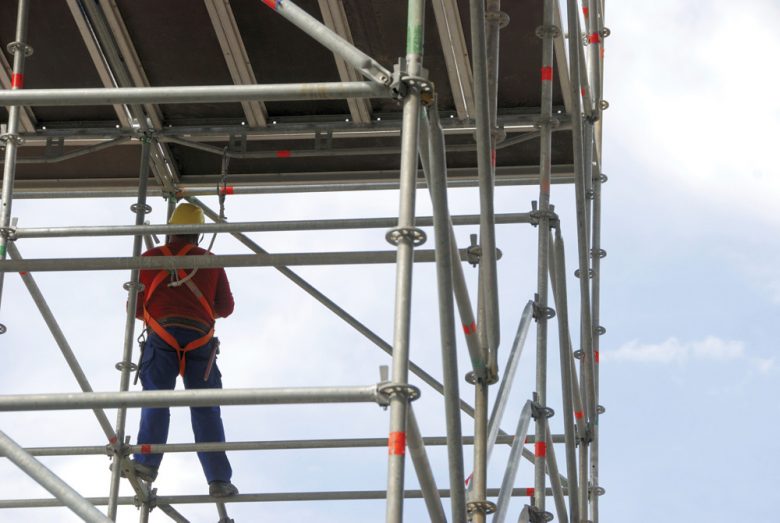Fall protection, scaffolding and ladders find themselves on OSHA’s top ten violations list almost every year. It’s clear that, despite clear regulations and obvious hazards, working at heights remains a significant risk. According to the 2017 edition of the National Safety Council Injury Facts:
- falls from heights are the second-biggest cause of workplace fatalities;
- there are almost 10,000 injuries each year in the construction industry alone; and
- falls are one of the three most expensive causes of injuries in medical compensation costs.
Additionally, there are over 50,000 “struck by falling object” recordables every year, which means that working at heights is also dangerous to those on the ground. People and objects fall for similar reasons and a new guide on working at heights aims to address them all. It’s an informative resource that addresses the standard approaches and solutions, but also adds another vital step that is missing from most safety programs.
Causes of falls
Working at heights is clearly dangerous and it’s important to ensure that workers are safe whether they’re on platforms, roofs or ladders. But few people realize that more than 40% of fatal falls occur from 15 feet or less and the most common height to fall from is 6-10 feet. These heights often don’t appear to be dangerous, especially to people who are used to working at 30 feet or more. And this one issue—the human factor—is only one of several that the standard practice misses out on.
The list of specific factors affecting safety at heights is worth examining, especially since engineering solutions alone are not enough. The factors include:
- complacency;
- normalization of risk;
- compounding risks;
- supervisory effectiveness; and
- human error.
Read the guide for more details on each factor, since they can’t all be covered in detail in this post. But two factors are such a major contributor to falls from heights that it’s worth taking a closer look at them here.
“I know what I’m doing”
When compounded, factors other than height seriously increase the risk of working at heights, especially when workers are comfortable with their job. This comfort makes them complacent and unaware—or dismissive—of the compounding risks in front of them. But complacency and compounding risks are a dangerous mix.
It’s important for workers to know that each suboptimal condition and each human factor that is present increases the likelihood of a fall. For example, if the worker is complacent with a particular task, there’s a gap in safeguards and rushing is added to the mix, the risk they’re exposed to is exponentially larger than normal. But it’s possible to offset compounding risk elements with three tools:
- knowledge that risk expands as more elements are present—simply understanding compounding risks can make workers think and look twice when it matters;
- the ability to recognize various risk elements as they appear;
- understanding how to offset risk—will workers take a moment to clip their harness or tether their tools? Will they monitor their traction or double-check things when rushing?
These three elements might seem obvious but how many workers actively use all of them on a regular basis? Performing the same jobs and actions for months and years can lead workers to believe they know everything there is to know and that nothing will surprise them anymore. They know what they’re doing. And since nothing happened so far, they might think nothing will happen in the future. Or worse, they won’t think about the risk at all. This is complacency at work.
Plan, provide and train
So how can workers, and people below, be kept safe? The standard advice from OSHA—plan, provide and train—is a three-step approach that aims to prevent falls from heights:
- The first step is to carry out a risk assessment and consider the actions that should be taken to avoid hazards.
- The second step is to ensure working conditions are free of hazards and to provide workers with the right equipment for the job, including safety gear to address any known dangers that cannot be eliminated through engineering solutions.
- The last step is training. Workers need to be trained about job hazards and the proper setup and use of their equipment, including safe practices.
This approach, although excellent, misses one of the main causes of falls: the human factor. Of course, you should tackle the physical and procedural items first by installing engineering solutions and teaching workers how to work safety at heights. But companies also need to address human factors in their process to help people understand all of the risks, why they need to comply all of the time and how to remain vigilant.
One more step
Engineering solutions are a must, but there are still gaps made by complacency, compounding risks, human factors and the normalization of risk. However, there are steps that can be taken to prevent workers from falling through these gaps.
Download the guide Raising the Bar—A Safety Guide to Working at Heights, not only to brush up on the plan, provide and train approach, but also to learn the additional steps that can be taken to tackle the human factors affecting worker safety at heights.

